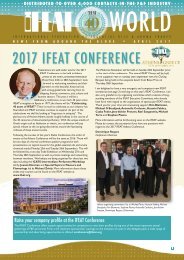Create successful ePaper yourself
Turn your PDF publications into a flip-book with our unique Google optimized e-Paper software.
16
WORLD
VANILLA
A TRADITIONAL FLAVOUR BUILT FOR THE FUTURE
VANILLA: A TRADITIONAL FLAVOUR BUILT FOR THE FUTURE
Based on tradition and part of our
modern world, vanilla is one of
the flavours most appreciated by
consumers globally.
Historically, and still today, vanilla
is grown in tropical climates
around the globe, Madagascar
being the country with the highest
rate of vanilla exports worldwide.
The green vanilla beans are still
cultivated and cured by traditional
methods which are highly labourintensive,
and the plantations are
vulnerable to climatic variations.
In recent years, demand for
natural vanilla has soared as the
popularity of foodstuffs free of
artificial flavourings continues to
grow. Consequently, vanilla bean
prices have increased greatly with
speculation, accompanied by a
BY CORINNE DUFFY,
SOLVAY AROMA PERFORMANCE
decrease of quality linked to early
harvesting.
The growing demand in vanilla
flavours cannot be met by the
limited amount of cultivated vanilla
bean crops; so, how can we satisfy
demand for the real thing when its
supply is running so dangerously
low?
The natural answer is vanillin, the
principle molecule found in cured
natural vanilla beans; in order
to satisfy the increasing global
demand for this highly favoured
flavour, ingredients suppliers have
developed a range of vanillin types,
ranging from synthetic to natural
vanillins, including US natural
vanillins. In the graph opposite, we
can see the various types of vanillins
commercially available.
FROM CURED
VANILLA BEANS
Originally, vanillin comes
from vanilla beans in the form
of glucovanillin, linked to a
carbohydrate moiety and released
by the curing process. Vanillin is the
main organoleptic characteristic
aroma component, naturally
occuring in cured vanilla beans
between 1 and 2% of the dry matter.
US NATURAL
VANILLINS
The main product available on
the market is vanillin ex-eugenol,
produced by conversion of eugenol
to isoeugenol, followed by catalytic
oxidation, the process conditions
not meeting the definition of natural
process according to EU regulation
EC 1334/2008, and accepted as






